First Lego League 2014: Teamwork Takes Flight
Congratulations to the 2014 Team! They received a first-place trophy at the regional competition November 15th at the Southwest Virginia Higher Ed Center in Abingdon. The Flaming Phoenix Team will compete in the State tournament at James Madison University on December 6th and 7th.
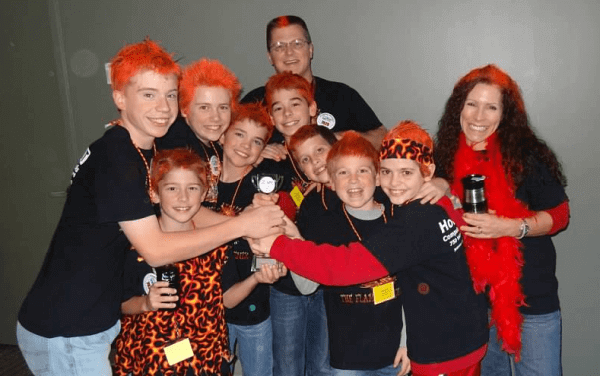
Glenn, Grayson, Peter, Ian, Zachary, Coach Steve, Alex, Abram, Nick, Coach Julie
There are three components to the FIRST Lego League competition. Each team must:
1. Build a robot, and program it to accomplish missions on the Competition Table.
2. Research a real-life challenge and create a solution to it (the “Project”).
3. Learn about the Core Values and practice them, as a team and as individuals.
Robot
In August, the team members gathered around this year’s competition table for the first time. Their task: study the layout of the table and the accompanying challenge missions. Determining which missions they wanted their robot to accomplish led them to design the robot with certain features.
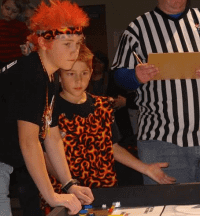
The timer is ticking as Peter & Grayson watch their robot (named “R2D2”) do its work. They are only allowed to touch the robot when it is in the corner where they are standing. They receive penalties for touching it anywhere else on the table. The goal is to program the robot to leave the corner, go perform certain tasks, and then return to the corner. When it returns, they can add attachments or point it in a different direction before sending it out to do more missions.
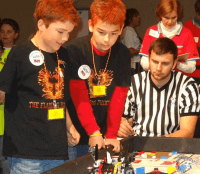
Ian, Zachary, and judges watch the robot take off again.
Each team had four turns at the competition table, and the highest score from all of those rounds counted as their Robot Performance score.
Each round at the table is 150 seconds. The tension is high!
Project
FIRST Lego League is about more than building and programming Lego Robots. Each year, teams also must apply their researching and problem solving skills onto a real-world challenge.
This year’s challenge was:
1. Choose a topic that you are passionate about or always wanted to learn.
2. Create an innovative solution that improves the learning experience.
3. Share your solution with others.
Here’s an explanation of what our team did this year for their project, as told in their own words. They gave an oral presentation to a panel of judges, but we did not videotape it.
Abram:
Hi, I’m Abram, the Flaming Phoenix project manager, and I would like to tell you our world class question and our solution. On one of our first meetings we got together and thought, “What would our world question be?” Our idea was a better way to learn how to fly an airplane.
We talked to several experts and we figured out that flight simulators are one of the best ways. But, they do have their problems. So I am going to hand it off to Grayson and he is going tell you our first problem.
Grayson:
Our first problem is that flight simulators do not have 360 rotation. Now Nick is going to tell you our solution.
Nick:
Thank you Grayson, our solution was simple. We designed a ball, created from rings, connected to an interchangeable cockpit in the middle by wheels. This contraption gives the simulator 360 degree motion.
That’s all I’ve got to say about this solution. Now Peter will tell you about the next problem.
Peter:
Another problem we figured out was that Flight Simulators today have bad, if any, communication. We thought that it is pretty important in military and nonmilitary flight simulators to be able to communicate with other fighter jets or the radio control tower, and it would help if they have experience doing both at the same time.
I will hand it over now to Ian to explain the solution to flight simulator communication.
Ian:
The solution to the problem Peter just told us about is to have a radio transmitter on the F-360 flight simulators. The pilot will be able to communicate by radio to pilots in other flight simulators and talk about their plan of action.
Or, if one pilot needs help, he can radio one of the others. The assisting plane will then appear on the pilot’s screen. These communication channels can be used in many different ways. Now, Zach is going to tell you about another problem we discovered.
Zachary:
Another thing we found out is that military flight simulators have poor artificial intelligence. We feel that is a problem because if you don’t have enemies in flight simulators, the first time you get in the air you won’t be used to it and you won’t stand a chance. And now, Alex will tell you our solution.
Alex:
Our solution is using the communication Ian just talked about. When you fight with or against other simulators, the computer will take their fighting tactics and style and use against you in the future.
Glenn:
This is our FLL world-class solution: the F360 [at this point the boys showed a 3D model of their flight simulator]. From the minute you board the F360, you feel just like you’re in a real cockpit.
It has flex-screen technology and interchangeable controls, so it can simulate any type of plane. With a reliable drive system and automatic brakes, it can complete 360 degree rotations of pitch, yaw, and roll. It also has a fully automatic platform.
If you want to simulate a fighter jet, the software is designed to cause your mind to believe you are under full G-force, which creates a real physical reaction. The virtual reality provides an extremely realistic flight experience. Equipped with radio communication, pilots on multiple F360 simulators can interact with each other and ground control.
We met and discussed ideas with Wes McConnell, who is a private pilot, and Jared Kruger, who is an Air Force pilot. The team also met with Lewis Neal and Chris Rowe, who are engineers with Bell Helicopter. And we talked to someone in customer service from Redbird Flight Simulators.
In these two videos, you can see a bit of the Question-and-Answer session between our team and the judges of their Project.
Core Values
The third aspect of the FIRST Lego League Competition involves Core Values.
You can read more about this at http://www.firstlegoleague.org/mission/corevalues
Here are the Core Values toward which all competing teams should strive:
Inspiration
- Discovery — The team has a balanced emphasis on all three aspects of the competition (Robot, Project, and Core Values). It’s not just about winning awards.
- Team Spirit — The team engages others in their enthusiasm and fun; they have a clear identity.
- Integration — Team members apply FLL values and skills in their daily life.
Teamwork
- Effectiveness — Clear processes enable the team to accomplish well-defined goals.
- Efficiency — Time management and role definition allow the team to accomplish its goals.
- Kids Do the Work — The kids work independently with minimal coach guidance.
Gracious Professionalism
- Inclusion — The team displays consideration and appreciation for the ideas and skills of all team members, with balanced involvement.
- Respect — Team members act and speak with integrity so that others feel valued—especially when solving problems or resolving conflicts.
- Coopertition — The team competes in the spirit of friendly competition and cooperates with others.
To assess whether the boys had internalized these values, a judging panel gave them a short, timed challenge and watched them solve it as a team. Then the judges interviewed the team. This year’s challenge: they were given a stack of office supplies and told to build a tall tower with them.
Additionally, there were “hidden judges” throughout the day who were walking around observing the teams and evaluating their adherence to these principles.
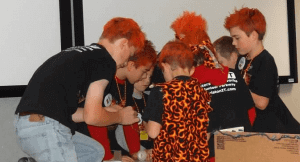
Putting their heads together: The boys attack the challenge the judges just gave them. As part of the Core Values competition, the team completes a challenge in front of a group of observing judges.
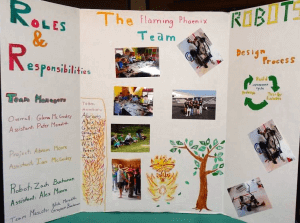
This display explains the roles of each team member. All eight boys played a part in each aspect of the competition, but each team member’s responsibilities was unique.
Tech Eagles is proud to be part of supporting such an excellent program which fosters critical thinking skills in our young people.
